SUMMARY
This is AI generated summarization, which may have errors. For context, always refer to the full article.
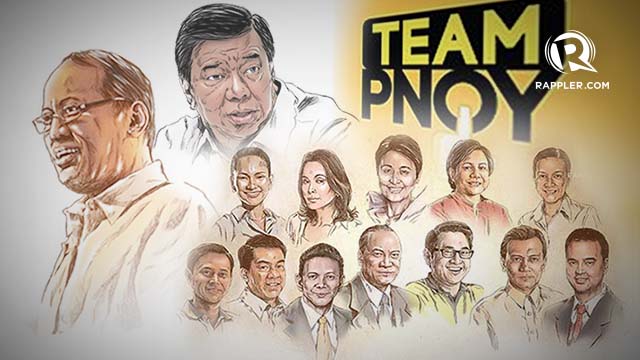
MANILA, Philippines – On Oct 12, 2012, President Benigno Aquino III took the stage at Club Filipino’s Kalayaan Hall to present the administration’s senatorial slate. It was the same venue where he announced his presidential bid in 2009, and where his mother, the late Corazon Aquino, took her oath as president in February 1986.
Inside the room were some of the country’s most powerful government officials, politicians, familiar faces of campaigns past. Some were former political rivals, others were longtime allies — but that day, all of them were partners.
Behind the President, sitting on stage, were 12 individuals decked in various colors — red, white, yellow, green — from 5 different parties, each one handpicked by Aquino and his team. Aquino introduced his rainbow coalition as an alliance with a common goal.
“Silang labindalawa po ang kumakatawan sa alyansang LP, Akbayan, NPC (Nationalist People’s Coalition), NP (Nacionalista Party), LDP (Laban ng Demokratikong Pilipino). Sila ang rumesponde sa panawagan nating magbuo ng samahan ng mga pareho ang paniniwala, at nangangakong itataguyod ang agenda ng mabuting pamamahala,” he said. “Labindalawa po silang pinili mula sa unang listahan ng 40,” he said.
(They are the 12 who make up the coalition of LP, Akbayan, NPC, NP, LDP. They are the ones who responded to our call to form a group with the same beliefs, and promised to continue our agenda of good governance. They are the 12 chosen from a list of 40).
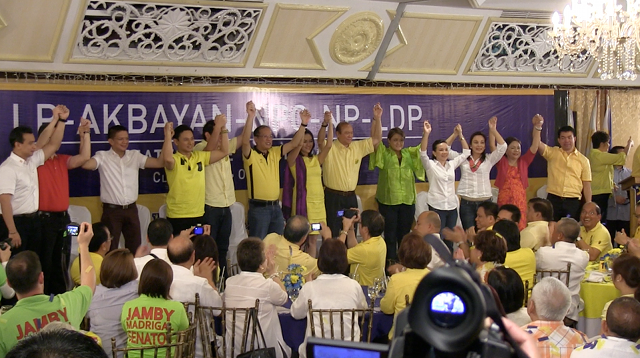
The group of 12, with the President smack in the middle, held hands and raised each other’s arms — a coalition, it appeared, tightly united.
The formation of the alliance was not entirely painless.
Every Monday, starting in 2012 and leading up to the 2013 campaign period, a core group of some of the President’s trusted men would gather to discuss the pending midterm elections. Together, they dissected, debated and determined the intricacies of messaging and strategy, selected the candidates, and negotiated with the parties that ultimately created the administration’s coalition.
Core group
The core group was assigned specific tasks by Aquino.
Interior Secretary and LP president-on-leave Mar Roxas was tasked to oversee both the senatorial and local races. For the senatorial slate, LP vice chair turned campaign manager Franklin Drilon called the shots, while LP secretary-general and 1st district Western Samar Rep Mel Sarmiento primarily handled the local campaigns. Budget Secretary Florencio Abad, in his own words, also helped with “firefighting… and shuttle diplomacy work,” while acting party president and Transportation Secretary Joseph Emilio Abaya said he helped with the local bets and in “filling in the gaps.”
This was the main group that did the decision making, a process which, they said, was relatively easy, or in Abaya’s words, “collegial.”
But the planning did slow down when it came to picking the bets, according to Abad.
When it was time to form the senatorial slate, a coalition with the NP and the NPC was a natural choice. Abad said there was already “a foundation to it,” with most of the bets having allied with Aquino in legislative battles. That way, the ruling party “did not have to dangle pork barrel,” he said, with the parties openly “adhering to his leadership.”
The first order of business was to sit down with the NPC, the ruling party’s biggest ally. Negotiations, headed by Roxas, were surprisingly efficient, and revolved mostly around local races and expectations in contentious places.
“There were only few things to negotiate because our meetings with NPC were time invested. We identified each district [and] the official candidates… and the free zones,” Abaya said. “In fact they readily accepted when we asked for free zones.”
Free zones are localities where parties that are coalesced at the national level don’t observe the “equity of the incumbent” rule at the local level, and instead field candidates against each other.
The agreement was clear: the NPC would use its strong, local machinery to support the full senatorial slate of the President, while the LP would not field candidates in areas where there were incumbent NPC officials, except in free zones. In these places, NPC also agreed to the LP’s stance that Aquino be allowed to endorse his LP candidates.
“They accepted that. So it wasn’t that difficult for Mar,” Abaya concluded.
The agreement later paved the way for topnotcher Sen Loren Legarda of NPC joining the President’s slate.
After the NPC, the LP set its sights on NP. Abad led negotiations with NP, with whom they agreed on the same arrangements of adopting and respecting free zones. Abad agreed there were “certain discomforts” in negotiations, with “awkwardness arising from the 2010 elections.”
Talks with NP
The NP, headed by Sen Manny Villar, was a bitter rival of Aquino in the 2010 presidential race.
“You cannot avoid, in elections, raising issues. So you have to smoothen out those kinks for a while,” Abad said. “But Senator Villar was very cooperative because that was the past.”
From the NP, senators Alan Cayetano and Antonio Trillanes, as well as Sen Villar’s wife and former Las Piñas Rep Cynthia joined the list of Aquino’s bets.
The 3 parties also agreed that LP would have nothing to do with differences between NPC and NP. The two did not have an alliance with each other.
With the two parties in the bag, the LP then moved on to woo other candidates, some of whom Aquino had obviously favored as early as the first quarter of 2012 and brought with him around the country — namely Akbayan Rep Risa Hontiveros and Aurora Rep Sonny Angara. Also joining the slate were popular independent candidate Sen Chiz Escudero, former censors chief and Aquino appointee Grace Poe, and Sen Koko Pimentel of PDP-Laban who bolted the opposition United Nationalist Alliance after it welcomed his bitter political rival, former senator Miguel Zubiri.
And in a move surprising to some, the LP only fielded 3 of its own — newly sworn members Jamby Madrigal, a former senator, and presidential cousin and social entrepreneur Bam Aquino. The party also tapped 5-year-retired former senator Jun Magsaysay.
While there was some disagreement about the low number of LP members the slate was ultimately fielding — especially given the President’s popularity — most were of the same thought: regardless of the party, they needed people who would support Aquino’s reforms in the next 3 years. The winnability of the candidates was also a consideration, “paramount as values,” said Abad, ultimately leading to only 3 LP bets who fit the bill.
The product was the coalition Aquino presented in Club Filipino, his hodgepodge of a slate: Team PNoy.
President’s team
The idea to ingrain the President so deeply into the campaign was a consensus among the decision-makers, and one approved heartily by Aquino. By the end of 2012, the branding was crystal clear.
“There was no doubt. Everybody agreed that the main asset of the campaign is the president that’s why ‘Team PNoy,'” Abad explained. “The overarching message is tuwid na daan (straight and narrow path). And that is captured by the face of the President.”
Drilon said Aquino appearing in ads and endorsing his slate in numerous sorties throughout the campaign period was a given, a “package,” he said, that the LP group came up with in meetings.
“We reviewed it with the President and he cleared it. He knew that he was going to put his political capital on the line and he was willing to do it. And he knew that there was so much at stake and on his administration,” Drilon said.
With the branding all set, the group went right to work.
Consultations with advertising agencies and marketing personalities followed suit, including talks with Tourism Sec Mon Jimenez who was a prominent executive in the advertising industry before he was asked to join the Cabinet. Jimenez shared his input on messaging and what resonated with the public.
By the end of January, Team PNoy aired its first ad.
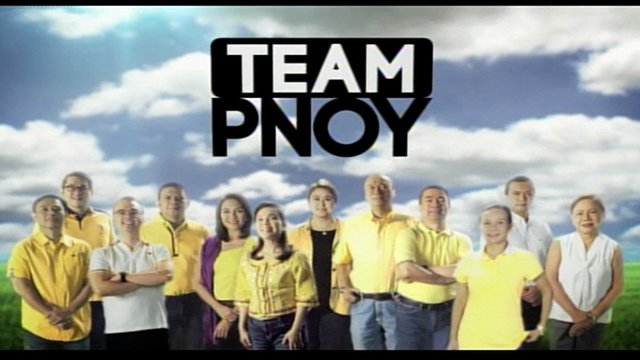
In it, the President doesn’t appear but his voice plays throughout the ad endorsing his 12 chosen ones, and hammer home a message: this is the team that will follow his straight and narrow path. He also warns of others who claim to be on his side but are only pretending.
The message of the first ad encapsulated the main message of the campaign. It banked on the popularity of the President — who enjoys a high 72% trust rating. It also slammed UNA for supporting Aquino but deciding to run against his slate.
It was the same message echoed in sorties throughout the country.
“On the first day of the campaign, I said they are the opposition, we are the administration. If you’d look back, that strategy is deliberate,” Drilon said.
Use of surveys
Once the campaign was in full swing, group meetings became less regular and were instead scheduled when necessary. Sometimes, the President himself would call for a meeting especially to discuss the senatorial race. Text blasts and emails were common to alert the group of important events of the day, and to discuss important issues. Phone lines were constantly open, and encouraged free flowing correspondence.
Initially planning to capitalize on media knowing its huge impact among Filipino voters, Drilon was forced to adjust the campaign’s strategy after the Supreme Court instituted airtime limits on national candidates in January, and prohibited them from going beyond 120 minutes on all TV stations, and 180 minutes in radio stations. Aside from media, making sure bets appeared on stage with the President became Drilon’s focus.
Drilon arranged rallies and sorties every week that allowed the exposure of the slate alongside Aquino. Aside from vote-rich provinces, the coalition also made stops in areas where the President’s bets — both national and local — needed an extra push.
Abad said the LP also lent “key personalities” to endorse candidates in specific places where they were extra influential, such as Roxas in Western Visayas and the Osmeñas in Cebu. Provincial visits were coupled with radio guestings to let the voters know the candidates were there in their area — knowing that only a small percent of the population attends sorties.
But one thing Abad said was distinct about the 2013 elections was the “increasing use of surveys” to “manage the campaign better and ensure victory with the use of empirical data.”
The coalition tapped the expertise of Sen Serge Osmeña, who helped analyze and structure survey questions. They studied national surveys, as well as used in-house polls, to study not just how their candidates were faring but to look at the opposition’s trends as well. They studied areas of strength and weakness, candidates’ awareness levels, voters’ demographics and details to strengthen the campaign.
A steady stream of finances from donors and supporters was also helpful — with cash not being much of a problem.
“The traditional sources of support, they are very happy,” Abad explained, saying those who invested at the start of Aquino’s presidency has since doubled their money.
“[It] is not just politics, it’s also economics. If I am a businessman, and this government is not a corrupt government and in fact it is expanding my opportunities for growth… it’s a matter of obligation. I want to grow further,” he said.
By March, surveys showed a 9-3 win in favor of Team PNoy, a rise from 7-5 the month before. The prediction has remained constant throughout, up to the very last Social Weather Stations survey released less than a week before the elections.
Shaping senators
Aside from scheduling sorties, rallies and interviews, candidates were also offered resources in the form of survey analyses and advice. Assistance in conceptualizing ads, especially with the president, were also available. For sorties, Team PNoy provided the plane ticket and accommodation of the candidate plus one aide.
Ultimately, Drilon said it was the bets’ decision whether they would take their help or leave it.
“At the end of the day, you have to respect the decision of the candidate because their lives are on the line and not you. You can only offer to assist, to arrange things… The reality out there is ‘I make my own judgment where I will benefit best in a situation like this,'” he said.
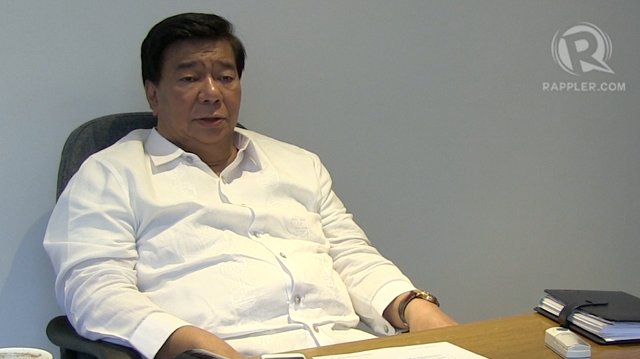
A veteran campaigner and a meticulous observer, Drilon spent the first two weeks listening and scrutinizing his bets on stage. From his observations, he suggested improvements in strategies, tweaking of messages, and better presentation techniques. He met with campaign managers of his bets and suggested ways to improve, even recommendations on how to deal with controversies, but was “careful not to impose.”
His main advice? Consistency.
“[I tell the bets], before you go out there, you must figure out studies and surveys and what you identify with,” he said, citing Legarda and Cayetano as prime examples of campaigns that stick to one message.
He pointed to Angara as someone who needed to adjust.
“In the case of Sonny Angara, he has too many areas being covered and he starts with Sarah Geronimo and Coco Martin. Then he talks about senior citizens. I told him, ‘Your survey shows that you’re identified with education, stick with it.’ I tell them that. Whether he accept it, it’s his decision,” he said.
While each candidate had their own team working on their image, he said all were guided by the basic guideline of presenting the candidate as a supporter of Aquino and his straight and narrow path.
Drilon admitted “there is competition especially on top,” but said the campaign has been largely smooth sailing. The difficult part, he said, has been mostly at the local level.
Local help
Aside from LP Sec-Gen Sarmiento, Deputy majority leader Neptali Gonzales and House speaker Sonny Belmonte played a huge part in sorting out coalitions on the local level.
Much work was done in making sure the coalition stayed as smooth as possible on the local level but despite the agreement between the parties on the national level, complications have been evident locally, with NPC provincial leaders flatly announcing they would not support the full slate of the President. The LP, they said, did not fulfill its end of the deal and fielded candidates against their incumbent officials.
It’s unfortunate, but expected, the LP stalwarts agree — knowing the factors that influence the local races are much different from the Senate race.
Abaya said there has not seen special efforts to try to convince local NPC officials to change their mind, but instead they leave them alone.
“At the end of the day I don’t expect everybody to be true to their words so that’s just the name of the game,” he said. “They have their own goals in life and missions in life and it’s just maybe a futile exercise at the end of the day.”
He also pointed out that the LP will assess those who were true to their word, and with another 3 years for Aquino, “it’s their relationship [with him that] they have to take care of.”
Abaya said it has been “quite difficult” for LP’s bets as well, “because there are some of our candidates who are of the old mindset… that if you are an incumbent, the police force, the Comelec (Commission on Elections), the teachers, the prosecutors should be with you.”
Such an expectation is far from reality under the President, Abaya said, and a challenge for those used to that treatment.
Instead, the LP provides what it can to their bets. They help raise funds for operational expenses of local bets, and poll watching. In big provinces like Cebu and Iloilo, they help find funding for ads, as well as funding for house-to-house visits in smaller places.
But it is largely Aquino’s influence and endorsement that forms the main part of their strategy on the local front — with the President visiting important local areas one, two, even 3 times to campaign for LP’s bets.
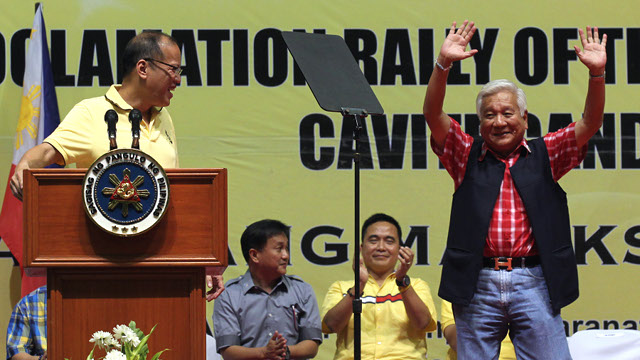
This is most important in 8 provinces tagged by the LP as battlegrounds, or places where the party is pushing hard for their bets to unseat an incumbent from a different party: Cebu, Cavite, Laguna, Quezon, Negros Oriental, Pangasinan, Zamboanga del Norte and Pampanga.
Aside from these provinces, Abaya also pointed to the importance of an LP victory in Manila’s mayoral race — between LP bet and incumbent Alfredo Lim and former President Joseph Estrada — as well as Maguindanao between LP’s incumbent governor Toto Mangundadatu and Mayor Tucao Mastura of Sultan Kudarat.
Eyes on the prize
On the campaign trail, Aquino faithfully fulfilled his duty of endorsing his slate, rain or shine. He campaigned even when he was sick, appeared in rallies even while violence in Sabah continued, and visited areas in the country never before visited by a president — making a historic stop in Buluan City, Maguindanao.
His significant efforts reflect what the party believes is at stake. Aquino’s involvement has been extraordinary, because his presidency, his team believes, has also been unusual.
“I’ve never seen a president so engaged in an election. That’s why it’s really Team P-Noy because you really have the president taking care of his candidates,” Abad said.
But it isn’t unexpected.
The LP has repeatedly said the elections will serve as referendum on Aquino’s leadership, hence the hard sell for a 12-0 victory.
“[Aquino] realizes the statement will be made by the results of the election, and the thing is you want to be able to sustain the reforms and hopefully make them institutionalized and therefore irreversible,” Abad said, emphasizing the need to create policies in Aquino’s last 3 years.
He cited the administration’s “critical battles” like the passage of the sin tax bill, the reproductive health law and the impeachment of chief justice Renato Corona, and said “there are many more fights of that nature as you address problems that have deep historical and structural roots.”
Among the reforms Aquino is still eyeing include the challenge of job generation along with the economic growth, expanding the revenue base, eradicating smuggling and the peace process in Mindanao.
“This is no easy task, so he has to have the support both from the House and Senate to be able to give flesh to whatever final framework or peace agreement. This is an example as to why we needed to have majority from both Houses sympathetic to the President because these are agenda items that need support,” Drilon explained.
Satisfied
The stalwarts are happy with the way they have run the campaign.
Aside from its more organized nature compared to 2010, Drilon said it has been easier in the sense that Aquino is “very popular.” Surveys, he said, indicate people don’t mind the President’s decision to go out of his way to campaign.
“I think I understand why UNA is surprised at the involvement of the President in the campaign,” he said.
Abad too is satisfied. Aside from what he believes has been a strong campaign, he said UNA’s weak messaging has helped them.
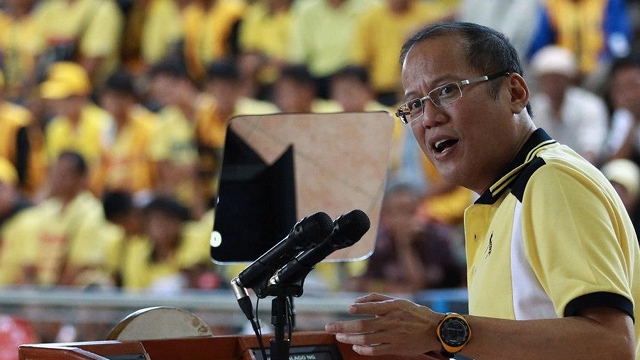
“We are a presidential system and it’s always going to be a bipolar fight. The incumbent versus the opposition. So if you are an incumbent as we are, we are able to define ourselves very sharply. The problem of UNA is it has not. It cannot be a clear alternative to the administration and that is their undoing fundamentally,” Abad said. (Read: UNA: The opposition that’s not quite)
He said UNA’s “fundamental weakness,” is that Vice President Jejomar Binay, the symbol of their coalition, is a member of Aquino’s Cabinet.
LP also showed little concern about the possibility of their current allies turning against the ruling party once in power, especially in the lead up to the 2016 presidential elections. Confident of the popularity of the President and the reforms yet to come in the next 3 years, Abad expressed trust the support would keep flowing.
“2016 is 3 years away and as they say 3 years in politics is a long time. But one thing you can be sure of and this has been proven historically… is if the President becomes hugely successful, by the time he ends his term, we believe that our people will turn to him and say, Mr. President, who do you think should be next? And I think he would have a huge influence in deciding who should be next,” he said.
But the first decision that looms isn’t 3 years away, nor several months away. It’s two days away, when the country’s 52 million registered voters go to the polls on May 13.
They will need to decide whether the President has proven himself in the past 3 years, and whether the arms he has lifted in the campaign, are indeed worth their trust. – Rappler.com
Add a comment
How does this make you feel?
There are no comments yet. Add your comment to start the conversation.